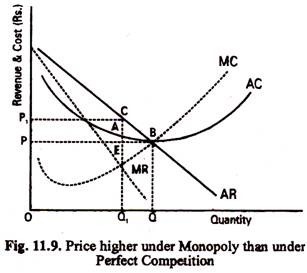This article will help you to learn about the difference between monopoly and perfect competition.
Difference between Monopoly and Perfect Competition
We often make a comparison between monopoly and perfect competition. Such a comparison is done in Fig. 11.9. If Fig. 11.9 represented the position of a firm under perfect competition then the equilibrium output would be OQ (where P = MC) and the price would be OP.
If, however, the diagram were to represent a monopoly situation, the equilibrium output would be OQ1 (where MR = MC) and the price would be OP1. Thus, monopoly output is less than competitive but monopoly price is higher than competitive price. The implication is clear if a firm does not have any competitors to fear, then it is in a position to raise its price.
Cost Considerations:
ADVERTISEMENTS:
The comparison made here rests on the assumption that the cost curves are the same in both types of markets. Such an assumption may not be correct. Because the monopolist is the only producer of the commodity, it is likely to be a very large firm that can secure economies of scale.
If it can derive the advantages of large scale production, then his marginal and average costs would be lower than those of a perfectly competitive seller. If this is so, monopoly price will be lower and output higher than under perfect competition.
Yet the truth is that a restriction of competition, as under monopoly, is likely to lead to higher prices and some other form of exploitation. This is why the government takes various actions to control monopolies and restrictive trade practices.
